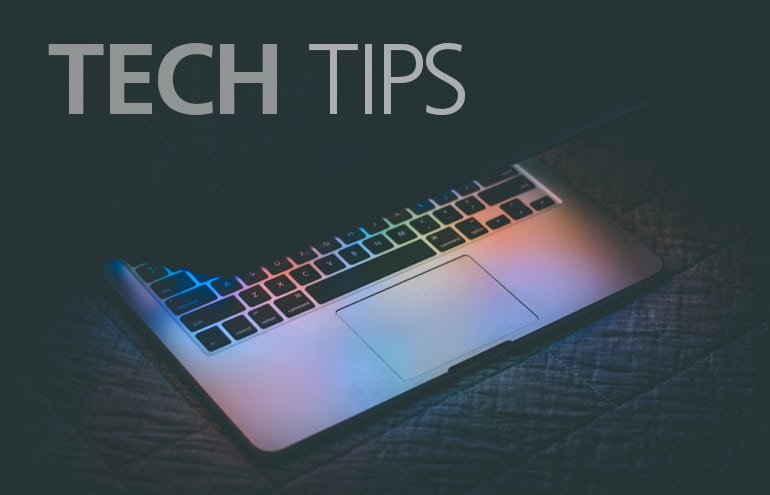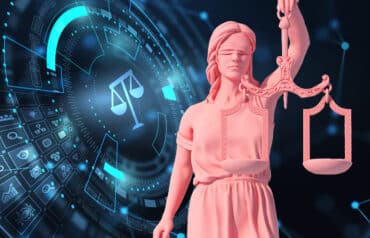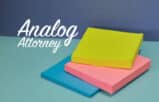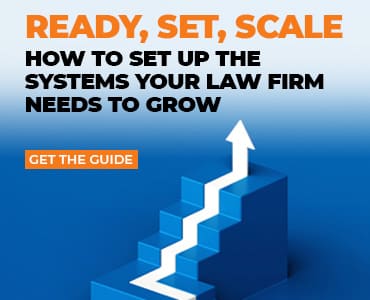It’s a common dilemma. You meant to start the new year in high gear, systems in check and revved up to tackle the projects and events ahead. But instead of getting organized over the holiday break, you found yourself binge-watching “Fleabag.” Now January has flown by and you’re in danger of veering off track for the months ahead. So we asked the practice management technology experts: What are some of the best tech tools and tips to jump-start productivity?
Here’s smart advice from Heidi Alexander, Sheila Blackford, Andrea Cannavina, Anne Haag, Natalie Kelly, Sharon Nelson and John Simek, and Nerino Petro.
Natalie Kelly: Take a Deep Breath and Get Things Calendared!
Taking the deep breath is easy. Just do it. Two to three minutes of doing nothing but looking at the ceiling, closing your eyes shut tight, and taking in long deep breaths ought to do it. Check out Pranayama breathing exercises on YouTube or consider apps like Box Breathing, Breathe2Relax and Calm for the technological fix.
Breath taken, move on to calendaring. Use an online calendar or scheduler — like a practice management calendar and a scheduling service like Calendly — and tackle overdue or office “fires” first. Schedule exactly when you will do them. Next review every open and active file, and add a calendar or appointment entry. Even if it’s just “review the Parker file” from 2:00 to 2:15 p.m. on February 18. Add administrative and non-client-related items, too. Once an entry exists for each file, put the file away.
Touch everything in front of you, and calendar it! You may be physically clearing a desk or file area, or removing digital clutter from your inbox, overcrowded dashboard or desktop. Calendar what you must do next and get to it — knowing you have everything under control. And, never forget to breathe!
Natalie R. Kelly (@NatalieRKelly) is Director of the Georgia State Bar’s Law Practice Management Program and a past ABA TECHSHOW chair. She is an Adjunct Professor co-teaching Law Practice Technology and a certified consultant for multiple legal software applications. Natalie speaks and writes extensively on law office management and technology.
Related: “Working from Home? Five Productivity Hacks to Help You Get More Done”
Heidi Alexander: Tame Email to Boost Your 2020 Productivity
Recently, I learned that according to a study conducted by Adobe, the average email user spends 5.6 hours per weekday checking email. With that in mind, I think we can all agree that email adds a huge stress to law practice. Spending most of your workday reacting to messages, you are confined to someone else’s schedule and not your own. Lack of control can contribute to stress and anxiety. While some things are unquestionably out of your control, I’d like to argue that email, on the other hand, can be in your control.
If you want to jump-start your productivity in 2020, you need to get your email under control. First, develop good email habits:
- Don’t check your email first thing in the morning;
- Schedule time to process emails; and
- When you check emails, if it takes you two minutes or less to respond, do it immediately.
Scheduling time to process emails is most important. If you keep your email client open all day long on your computer screen or get notifications each time you receive an email, you will waste a lot of time and find it difficult to accomplish your big rocks. This is much easier said than done. Lawyers suffer significantly from FOMO (fear of missing out). But, in reality, you don’t need all your information ASAP, and if there is something extremely important that cannot wait, then set your email client to alert you only if you receive an email from that particular sender.
Use your calendar to block out time in the morning and afternoon to process email. Whatever you do, don’t start your day by checking your email. This will only create unnecessary stress.
For processing it, use a system to sort and file your email, such as deleting emails you don’t need, responding to those that take two minutes or less, forwarding those that you can delegate, filing those for reference only, and flagging or using your task management system to collect those that require more thought or further action. Of course, technology exists to help shoulder the burden of processing emails, thus reducing the amount of time you spend managing email. For example, both SaneBox and Zero (for lawyers) apply AI to sort and file emails automatically, and more. Test these products out to see how much more efficient you can be in 2020!
Heidi S. Alexander (@heidialexander) is Deputy Director of Lawyers Concerned for Lawyers, where she also leads the Massachusetts Law Office Management Assistance Program (LOMAP). She is Co-Chair of the 2020 ABA TECHSHOW Planning Board, and sits on the Massachusetts Supreme Judicial Court’s Standing Advisory Committee on Professionalism. Heidi is the author of the ABA book “Evernote as a Law Practice Tool.”
Andrea Cannavina: Be More Productive Task by Task
Start with deciding what task needs to become more efficient. Then use this process:
- Track how you are doing that task now.
- Look for ways to remove steps (streamline) or automate them.
- Delegate to the lowest possible pay grade (as many tasks as you can).
Think SAD: streamline → automate → delegate.
Andrea Cannavina (@AndreaCan) is a personal productivity coach, LegalTypist CEO and Director of the Virtual Bar Association. She specializes in helping stressed-out professionals run organized and efficient offices.
Also read: “Spring Clean Your Gadgets, Gizmos and Website”
Nerino Petro Jr.: Make Your Outlook Life Easier With This Add-in
Everyone wants to get “on track” at the start of a new year, but too often those good intentions fall by the roadside. Your chance of success increases if you start with something less complicated and then build on that success to tackle more complex tasks. One of the best places to start is with your email.
For Outlook users, an often-daunting task is filing emails into the correct folders. Luckily, there are several third-party add-ins that can make your Outlook life easier and more efficient. My favorite by far is SimplyFile by TechHit Software. Simply File bills itself as an intelligent filing assistant. With a little training, SimplyFile will predict which folder an email should be saved to and with one click you can save the email to the correct folder. I usually get 90% plus accuracy. No more dragging and dropping emails to folders or trying to create Quick Steps in Outlook, which takes time and quickly becomes burdensome. SimplyFile gives you an option of which folder to save sent emails to as well. Check it out.
Nerino J. Petro Jr. (@NerinoPetro) is President of the Erickson Group in Rockford, Ill. Previously he was CIO for Holmstrom Kennedy PC and served as the first Practice Management Advisor for the State Bar of Wisconsin’s Practice411 Law Office Management Assistance Program. Nerino is a certified independent consultant for a number of legal products and a technology editor for ABA GPSolo magazine.
Anne Haag: Hit the Seven-Hour Mark
One of the best things you can do for your productivity is also one of the most obvious: sleep! Lack of sleep has been linked to disturbances in cognitive functioning, memory strength, and a decreased ability to absorb new information. If you can’t retain new facts of a case or your cognitive functioning is impaired, your productivity will suffer. Even more significantly, sleep disturbance has been demonstrated to contribute to all major psychiatric conditions, from depression to suicidality. Make a resolution to hit the seven-hour mark every night!
Anne Haag (@CBA_LPMT) is a Practice Management Advisor at the Chicago Bar Association. Anne worked as a patent paralegal at a Chicago IP firm before arriving at the CBA in 2017 as the Law Practice Management and Technology department’s trainer/coordinator. She is also a certified crisis counselor and volunteers as a patient advocate in the ER.
Check out this list of “7 Best Sleep Apps to Download” and read “Exhausted? Scrimping on Sleep Is Hazardous to Your Health.”
Sharon Nelson and John Simek: Get Free Software — Without the Malware
Various software programs can help law offices increase productivity. At the same time, many lawyers are extremely budget-conscious and are constantly looking for bargains, especially when it comes to technology. Probably the most coveted word for lawyers is FREE. As we advance in the new year, what better way than to take advantage of free Windows software? The challenge is that so much free software comes with “a little bit extra” stuff such as malware or activity tracking.
To help those who are financially challenged, Tech Viral has identified its favorite 15 trustworthy websites to download free Windows software:
- Ninite
- Softpedia
- MajorGeeks
- FileHippo
- Filepuma
- Download Crew
- File Horse
- SnapFiles
- DonationCoder
- Brothersoft
- Softonic
- Sourceforge
- Software Informer
- Soft32
- Freewarefiles
Sharon D. Nelson (@SharonNelsonEsq) and John W. Simek (@SenseiEnt) are President and Vice President of Sensei Enterprises, Inc., a digital forensics, legal technology and cybersecurity firm based in Fairfax, Va. They have written 16 books published by the ABA, including “The Solo and Small Firm Legal Technology Guides” and “Encryption Made Simple for Lawyers.”
Sheila Blackford: Stop Time-Wasting Paper Hunts With a Barcode Scanning System
Hunting for paper you have lost or misfiled is one of the biggest time-wasters that demolishes productivity. How to keep track? Ask a librarian or a salesperson at your local big-box home improvement store or the admissions desk of a busy hospital and you’ll be shown their barcode reader. Brilliant! There are ways that technology can help you to track information so that books, hammers and patients don’t go amiss. If you would like to avoid misfiling documents and files through using a system of barcodes and scanners, here are a couple of places to start:
- ccScan. You can use ccScan, a document scanning application that automatically imports, identifies and classifies your scanned materials into cloud-based CRM systems, like Salesforce, content management systems, and common file-sharing systems, including Box, Dropbox, Google Docs and Sharepoint. It works with TWAIN scanners like Cannon but not ScanSnap, which is not a TWAIN scanner.
- Scandit. Scandit seems to be a one-stop shop for generating barcodes — which can be scanned on smart devices. Yes, your iPhone or Android. They also have Matrix Scan to help you locate, track and decode multiple barcodes, and visual feedback to indicate which barcodes have been scanned.
Sheila M. Blackford (@SheilaBlackford) has been a Practice Management Attorney for the Oregon State Bar Professional Liability Fund since 2005. She is the author of the ABA book “Trust Accounting in One Hour for Lawyers,” co-author of “Paperless in One Hour for Lawyers,” and a contributing author to “Flying Solo: A Survival Guide” and the Oregon State Bar “Fee Agreement Compendium.”
Photo by Nadine Shaabana on Unsplash
Also from our experts
“Small Firm Tech Trends: What’s Coming Down the Pike in 2020?”
“Time Management Tips to Help Reclaim Your Weekend”
“Make the Most of Tools You Already Have”
Subscribe to Attorney at Work
Get really good ideas every day for your law practice: Subscribe to the Daily Dispatch (it’s free). Follow us on Twitter @attnyatwork.

















